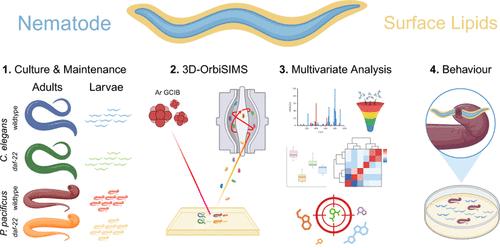Surface Lipids in Nematodes are Influenced by Development and Species-specific Adaptations
IF 14.4
1区 化学
Q1 CHEMISTRY, MULTIDISCIPLINARY
引用次数: 0
Abstract
The surface of an organism is a dynamic interface that continually adapts to its environment. In nematodes, the cuticle forms a complex boundary that protects against the physicochemical pressures. However, the precise molecular composition and function of this surface remain largely unexplored. By utilizing 3D-OrbiSIMS, an advanced surface-sensitive mass spectrometry method, we directly characterized the molecular composition of the outermost regions (∼50 nm) of Caenorhabditis elegans and Pristionchus pacificus to improve the understanding of species-specific surface lipid composition and its potential roles in nematode biology. We found that nematode surfaces consist of a lipid-dominated landscape (>81% C. elegans and >69% P. pacificus of all surveyed chemistries) with distinct compositions, which enrich in granularity and complexity through development. The surface lipids are also species-specific, potentially highlighting distinct molecular compositions that are derived from diverging evolutionary paths. By exploring the effect of mutations on lipid production, we found the peroxisomal fatty acid β-oxidation component daf-22 is essential for defining the surface molecular fingerprint. This pathway is conserved across species in producing distinct chemical profiles, indicating its fundamental role in lipid metabolism and maintaining the surface integrity and function. Furthermore, we discovered that variations in surface lipids of C. elegans daf-22 larvae contribute to significantly increased susceptibility to predation by P. pacificus. Therefore, our findings reveal that nematode surface lipids are developmentally dependent, species-specific, and fundamental in interspecies interactions. These insights pave the way for further exploration into the physiological and behavioral significance of surface lipids.

求助全文
约1分钟内获得全文
求助全文
来源期刊
CiteScore
24.40
自引率
6.00%
发文量
2398
审稿时长
1.6 months
期刊介绍:
The flagship journal of the American Chemical Society, known as the Journal of the American Chemical Society (JACS), has been a prestigious publication since its establishment in 1879. It holds a preeminent position in the field of chemistry and related interdisciplinary sciences. JACS is committed to disseminating cutting-edge research papers, covering a wide range of topics, and encompasses approximately 19,000 pages of Articles, Communications, and Perspectives annually. With a weekly publication frequency, JACS plays a vital role in advancing the field of chemistry by providing essential research.

 求助内容:
求助内容: 应助结果提醒方式:
应助结果提醒方式:


